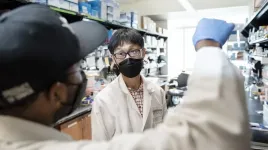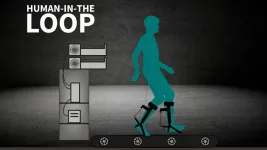(Press-News.org) ITHACA, N.Y. - House finches are locked in a deadly cycle of immunity and new strains of bacterial infection in battling an eye disease that halved their population when it first emerged 25 years ago, according to new research from the Cornell Lab of Ornithology.
House finch eye disease causes red, swollen, watery or crusty eyes. Afflicted birds can recover, but may die because they cannot see well enough to find food or avoid predators. The latest analyses, based on the observations of Project FeederWatch participants from eight Northeast states, addresses the long-term impact of the disease on house finch populations and points to the role of the finch immune system in the bird vs. bacteria battle.
"We have an escalating arms race," said Cornell Lab researcher Wesley Hochachka, first author of "Host Population Dynamics in the Face of an Evolving Pathogen," which published April 5 in the Journal of Animal Ecology. "Finches who become infected but survive acquire some immunity to that version of the bacteria and its predecessors. The bacteria evolve to get around the strengthened finch immunity. Then birds acquire immunity to the latest strain, and the cycle keeps repeating.
The study's authors believe that acquired immunity - when the immune system creates antibodies in response to an infection - is actually driving the arms race between the birds and the bacteria. They said imperfect acquired immunity, just like imperfect vaccines against human pathogens, creates the conditions needed to favor the proliferation of new strains of the bacteria that can overcome immunity acquired against existing strains of bacteria.
Immunity can also develop through genetic changes to the house finches, but this would be a relatively slow process, requiring multiple years for genetically novel and resistant finches to become widespread. In contrast, genetic changes to the bacteria can proliferate within hours - so fast that populations of house finches can't possibly evolve a defense quickly enough.
"We should really pay more attention to the role that acquired immunity can play in the dynamics of disease in any animal," Hochachka said. "Interactions can be much more complicated when both the host and the disease are able to change rapidly."
The overall house finch population was cut in half during the initial outbreak when the bacteria jumped to finches from poultry in 1994. House finch populations now are mostly stable at their current, lower level.
Hochachka said that's surprising because typically in other tracked animal diseases, either the animal populations rebound or fluctuate widely following the initial disease outbreak. But he thinks the finch population is not likely to return to pre-disease levels.
The finch eye disease dynamic has parallels to human health and the use of vaccines to give people acquired immunity to diseases. Here also, imperfect immunity - vaccines that do not provide perfect protection - are believed to accelerate the spread of new strains of pathogens against which vaccines are ineffective.
"The emergence of new diseases is going to keep happening," Hochachka said. "We just have to develop methods and systems for dealing with it as best we can when a lethal disease appears."
INFORMATION:
The research was partly supported by the National Science Foundation, the National Institutes of Health and the U.S. Department of Agriculture.
A recently published article in the Molecular Plant-Microbe Interactions journal provides new evidence that pathogens are hijacking the plant immune system to cause disease while providing insights into a newly discovered mechanism.
A large variety of pathogens infect plants and cause different diseases, which can lead to reduced crop yields. During infection, pathogens secrete effector proteins into the plant cell. Some of these proteins target plant proteasomal degradation machinery, which is responsible for recycling proteins to regulate cell processes. Some E1, E2 and E3-ligase proteins have been identified as playing a role in plant susceptibility ...
PHILADELPHIA, PA - The first National Institutes of Health (NIH) National Cancer Institute (NCI)-funded clinical study examining stereotactic body radiotherapy (SBRT) in the treatment of oligometastatic breast, prostate, and non-small cell lung (NSCLC) cancers displayed evidence that SBRT can be safely used to treat patients who have multiple metastases. These results were recently published in JAMA Oncology.
The results of the Phase I NRG-BR001 trial, conducted by the NCI National Clinical Trials Network group NRG Oncology, indicate that SBRT treatment in ...
SAN FRANCISCO, CA--April 22, 2021--In their effort to understand the very earliest stages of life and how they can go wrong, scientists are confronted with ethical issues surrounding the use of human embryos. The use of animal embryos is also subject to restrictions rooted in ethical considerations. To overcome these limitations, scientists have been trying to recreate early embryos using stem cells.
One of the challenges in creating these so-called synthetic embryos is to generate all the cell types normally found in a young embryo before it implants into the wall of the uterus. Some of these cells eventually give rise to the placenta. Others become the amniotic sac in which the fetus grows. Both the placenta and the amniotic sac are crucial for the survival of the fetus, and defects ...
A new research paper examining the relationship between the Omega-3 Index and risk for death from any and all causes has been published in END ...
The extended Baryon Oscillation Spectroscopic Survey (eBOSS) collaboration has released its latest scientific results. These results include two studies on dark energy led by Prof. ZHAO Gongbo and Prof. WANG Yuting, respectively, from National Astronomical Observatories of the Chinese Academy of Sciences(NAOC).
The study led by Prof. Zhao was recently published in Monthly Notices of the Royal Astronomical Society.
Based on eBOSS observations, Prof. ZHAO's team measured the history of cosmic expansion and structure growth in a huge volume of the past universe, corresponding to a distance range between 0.7 and 1.8 billion light years away from us. This volume had never been ...
A joint research study by the Pacific Water Research Centre at Simon Fraser University and the Fraser Basin Council points to the use of certified, nature-based solutions for protecting salmon and aquatic habitats in the Lower Mainland.
Salmon face various threats in the Lower Fraser Watershed (where the Fraser River passes through the Metro Vancouver geographical area), including habitat loss due to urban development and toxic stormwater runoff, which is projected to worsen due to climate change-driven extreme rain events.
The END ...
Like tree rings, cave stalagmites are a portal to a prehistoric Earth, and now scientists from UNSW Sydney have found they are consistently reliable as time trackers the world over.
In a global investigation into the growth properties of stalagmites distributed across the world, the scientists found that while growth fluctuations due to climate events are evident in the shorter period, stalagmite growth over the longer periods - tens of thousands of years - are surprisingly linear.
"Our new global analysis shows that we can consider stalagmite growth as being like a metronome and very ...
WASHINGTON-- Glacial melting due to global warming is likely the cause of a shift in the movement of the poles that occurred in the 1990s.
The locations of the North and South poles aren't static, unchanging spots on our planet. The axis Earth spins around--or more specifically the surface that invisible line emerges from--is always moving due to processes scientists don't completely understand. The way water is distributed on Earth's surface is one factor that drives the drift.
Melting glaciers redistributed enough water to cause the direction of polar wander to turn and accelerate eastward during the mid-1990s, according to a new study in Geophysical Research Letters, AGU's journal for high-impact, ...
CHAMPAIGN, Ill. -- Attempts at restricting people's mobility to control the spread of COVID-19 may be effective only for a short period, researchers said. A new study examines people's mobility for seven months during the pandemic in the United States using publicly available, anonymized mobile phone data.
Reported in the Journal of Transport Geography, the study alerts authorities to the need for more manageable travel restrictions and policies that reduce COVID-19 exposure risk to essential workers - who, because they are required to be physically present at their workplaces, remained highly mobile during the pandemic.
The longitudinal study is one of the first to compare mobility data using a broad ...
Being unable to walk quickly can be frustrating and problematic, but it is a common issue, especially as people age. Noting the pervasiveness of slower-than-desired walking, engineers at Stanford University have tested how well a prototype exoskeleton system they have developed - which attaches around the shin and into a running shoe - increased the self-selected walking speed of people in an experimental setting.
The exoskeleton is externally powered by motors and controlled by an algorithm. When the researchers optimized it for speed, participants walked, on average, 42 percent faster than when they were wearing normal shoes and no exoskeleton. The results of this study were ...




